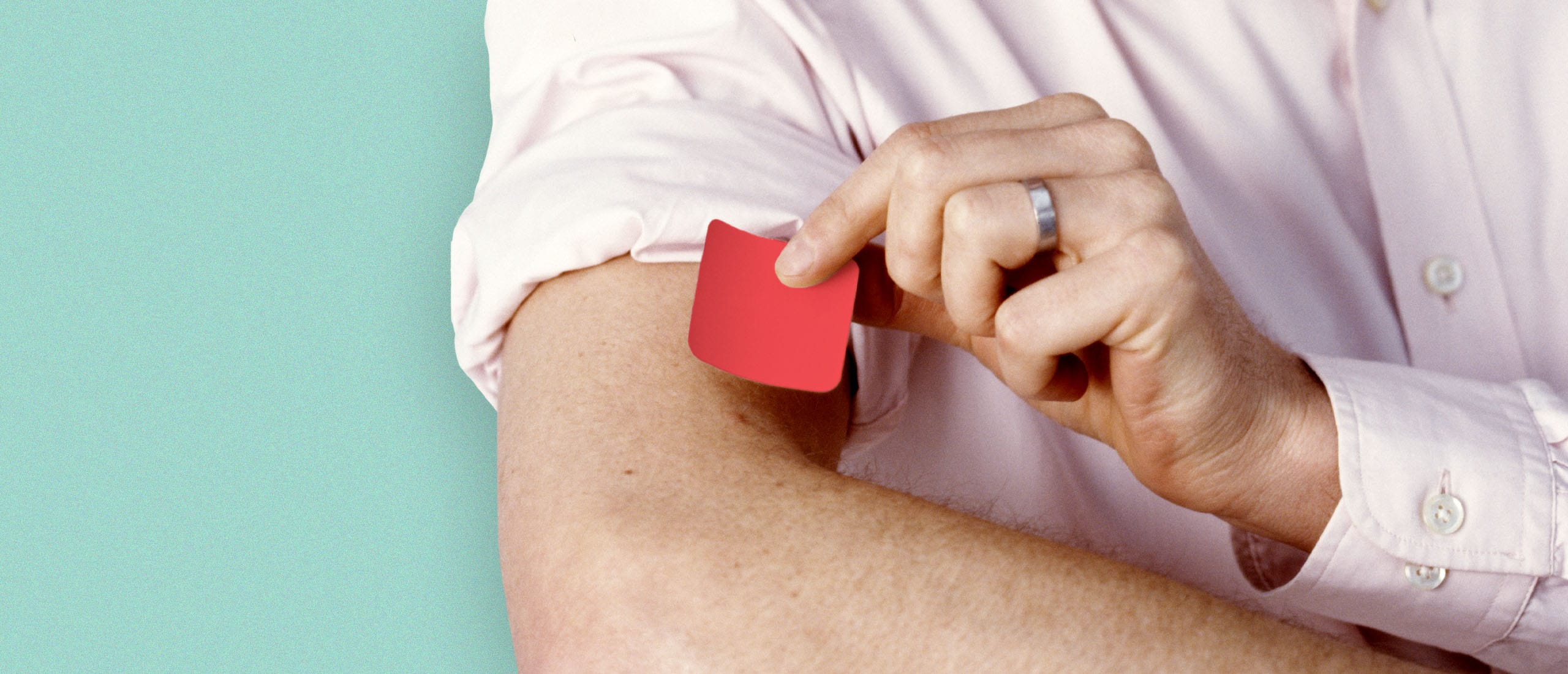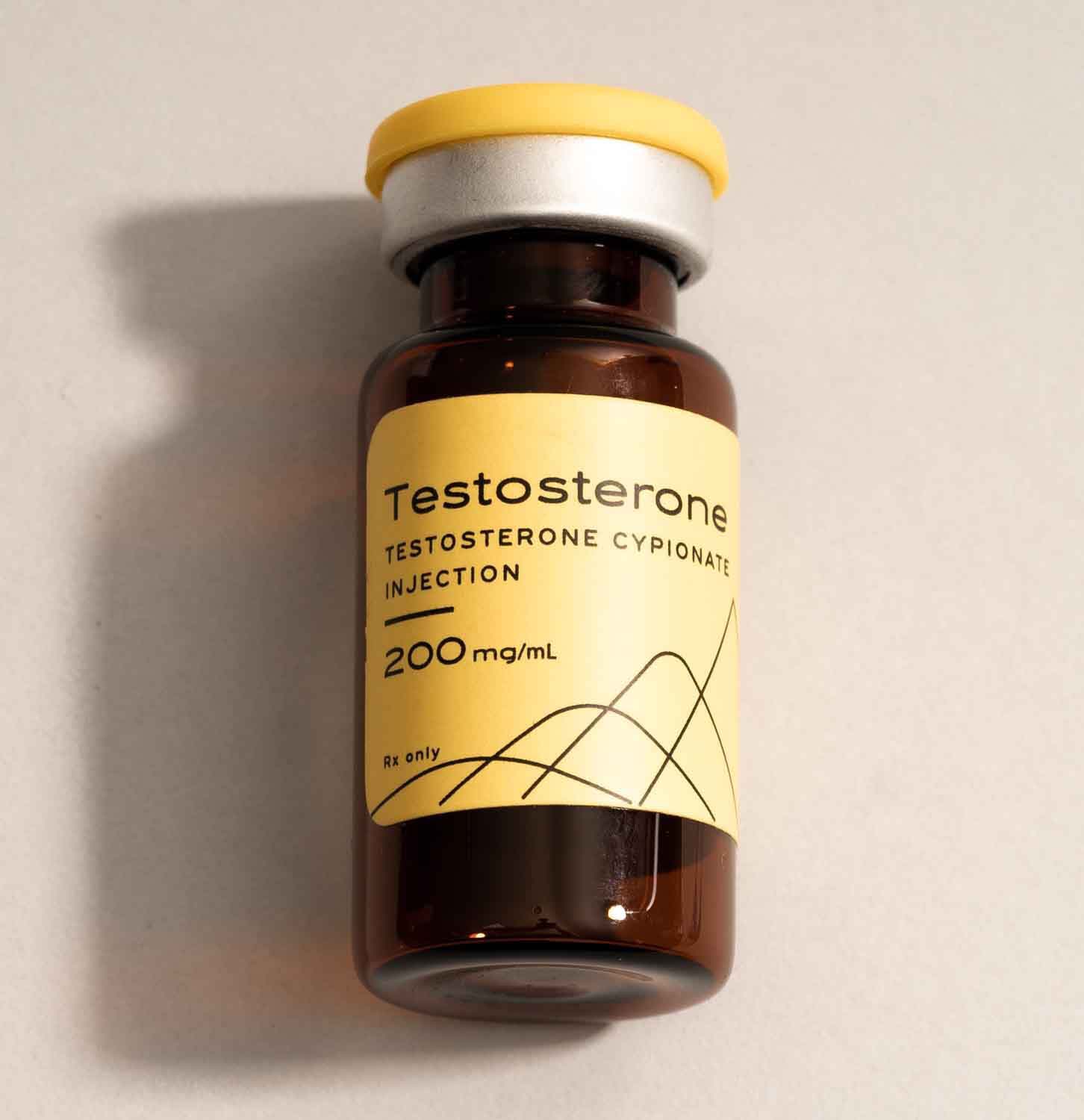Testosterone Patches: Is Stick-on TRT As Effective As Injections?
30-Second Takeaway
Testosterone patches are a form of testosterone replacement therapy (TRT) that doesn’t involve needles. You simply place one on your skin daily for a steady, 24-hour dose of testosterone. They’re great for people who fear injections, and who don’t mind reapplying.
Feeling like you need a forklift to get out of bed? The problem could be a testosterone shortage: Research suggests T levels can drop by up to 3% per year, typically starting around when you hit the big 3 0 (1). Fortunately, testosterone patches—a non-injectable form of TRT—can help boost you up.
Also known as hypogonadism, low testosterone can lead to mental and physical effects that may impact just about every area of your life. If you have low T, you might experience physical symptoms like erectile dysfunction, low libido, and reduced muscle mass and strength. Low testosterone levels can even cause your bone density to be affected, increasing the risk of osteoporosis.
The mental impact of having low testosterone can also be challenging, says Suzanne Manzi, M.D., a regenerative and anti-aging specialist who routinely prescribes hormone therapy. According to Manzi, you might feel as if you’re walking around in a fog, or you may even experience depression.
Testosterone replacement therapy can help alleviate these issues by regulating the testosterone levels. While testosterone injections are the go-to for many men, TRT is also available cream, troches (under-the-tongue lozenges, and testosterone patches which adhere to the skin.
The Skinny on Testosterone Patches
Testosterone patches look and work like nicotine patches for those trying to quit smoking: you apply them like a bandaid, and the active ingredient (testosterone, in this case), is absorbed by your skin. You stick a new one on each night before bed.
Finding the right form of TRT should be a decision between you and your healthcare provider, says Manzi, but she points out that testosterone patches deliver a consistent dose of testosterone into the bloodstream. “They’re a good option for those who prefer a non-invasive daily treatment.”
Available as a prescription under the brand name Androderm, testosterone patches come in 2 mg and 4 mg doses, and the option you use will be determined by a conversation with your doctor as well as testing that determines your current T levels. (Here’s how you can test your testosterone at home.)
The testosterone patch manufacturer notes that in a clinical trial, 97% of participants achieved normal T levels within 28 days of starting treatment. In terms of insurance coverage, you’ll want to check with your provider to see if the patches are covered. It’s possible that another form—such as injections or troches—will be reimbursed instead.
How to wear T patches
Apply the patch to a spot that’s not hairy (like your back), over a bone (like a shoulder or hip), or somewhere that’s under pressure while sitting. Never apply the patch to your scrotum or to an area where your skin is cut or irritated.
Choose a different spot for the patch each night to avoid sensitivity and wait at least seven days before applying another patch to a place you’ve already used. You’ll want to wait at least three hours after applying to swim or shower, but you don’t need to take the patch off after you get wet.
Benefits of Testosterone Patches
Like other forms of testosterone replacement therapy, T patches can help deliver longevity benefits. Greater focus and higher libido are both big ones. Here are more:
Lowered risk for depression
Although not everyone with low testosterone experiences mood swings, there is an established link between the two, with studies noting that this is both physiological and situational (2). Changes in body composition, erectile dysfunction, and decreased energy can contribute to a bad mood directly, and because they stress you out, which further lowers T.
The good news: Research looking at over two dozen clinical trials revealed that TRT is associated with a significant reduction of depressive symptoms, particularly at higher dosages (3).
Improved muscle mass
Much like your hormone levels, the amount of muscle you have shifts over time. You’ll naturally lose up to 8% of muscle mass per decade as you age (4).
You can slow this progression with strength training but if you’re losing muscle due to low testosterone, your gym sessions won’t be super effective.
That’s where TRT comes in: Research suggests testosterone replacement therapy improves muscle volume and strength, which goes a long way toward pumping the brakes on muscle mass decline (5).
Boosted immune function
Among the indirect effects associated with all forms of TRT, including testosterone patches: improved immune function. That’s because TRT may help reduce inflammation in the body, and when that happens, your immune system can operate more efficiently (6).
Deeper sleep
Research suggests the connection between testosterone and sleep is bi-directional: Poor quality sleep may lower testosterone levels and decreased testosterone levels may make your sleep even worse (7).
It’s an ugly cycle, but one you can break. Although TRT is not always recommended for people with obstructive sleep apnea (talk with your doctor if you have that condition, since you may need to control that first before starting TRT), those experiencing other sleep issues may get relief with TRT (8).
How Fast Do Testosterone Patches Work?
You may experience different T boost benefits at different rates. For example, research points to insulin sensitivity improvements in just a few days, but more extensive glycemic control could happen after three months or more (9).
The same review suggests that changes in fat mass, muscle strength, and lean body mass tend to occur within three to four months, but also keep improving to a modest degree over several years. Improvements in erectile function may take up to six months, but effects on depressive mood may be seen in only three weeks (9).
It all seems pretty great, but it’s key to note that TRT is not considered a short-term fix. Instead, it’s an ongoing treatment you may be on for life, as long as you’re seeing benefits. Once you stop TRT, your testosterone levels will drop and you may experience symptoms again. That doesn’t mean you need to be on it forever, and it’s always possible to lower the dose or stop completely, but be sure to consult with your doctor if you go that route.
Hone’s at-home testosterone assessment is the simplest way to uncover whether your levels are low. If you qualify for treatment, TRT can be sent right to your door.
Potential Testosterone Patch Side Effects
As with any medication, TRT patches can come with side effects. The Androderm manufacturer reports that if you already have an enlarged prostate gland, your symptoms may get worse with the patches, and that can include increased urination.
Other serious side effects could include: blood clots in the legs or lungs, lower sperm count with a larger dosage, swelling in the ankles and feet, sleep apnea, enlarged breasts, and increased risk of prostate cancer.
The most common side effects, however, are much milder: a headache and skin redness where the patch is applied.
Potential side effects like these highlight how essential it is to get regular follow-ups with your healthcare provider while you’re taking TRT, says Manzi. “It’s not a journey to embark on lightly, but with the right guidance, the benefits can significantly outweigh the risks,” she says.
Testosterone Patches vs. Injections
If you’re prone to skin irritations, another form of TRT—like troches or injections—might be better for you.
Older people may also want to stick with injections. That’s because some research has found that testosterone injections work better than patches in helping to prevent bone loss (10). The researchers found that injected testosterone helped increase bone mineral density more than patches, possibly due to the delivery mechanism (how the body might synthesize testosterone in the skin vs. in muscle).
The researchers revealed that testosterone injections could help increase muscle strength more, too. And even though the dosage is typically higher with injections vs. patches, injections didn’t increase the risk of prostate cancer like patches did.
Patches and oral testosterone also seemed to cause higher serum levels of DHT (a hormone in certain concentrations linked to cardiovascular disease and hair loss) vs. injected TRT.
Hone’s at-home testosterone assessment is the simplest way to uncover whether your levels are low. If you qualify for treatment, TRT can be sent right to your door.
References
1. Millar, A., et al., (2016). Predicting low testosterone in aging men: a systematic review
2. Khera, M., (2013)., Patients with testosterone deficit syndrome and depression
3. Walther, A., et al., (2019).,Association of Testosterone Treatment With Alleviation of Depressive Symptoms in Men
4. Volpi, E., et al., (2010)., Muscle tissue changes with aging
5. Shigehara, K., et al., (2022)., Relationship between Testosterone and Sarcopenia in Older-Adult Men: A Narrative Review
6. Bianchi, V., (2019)., The Anti-Inflammatory Effects of Testosterone
7. Wittert, G., (2014)., The relationship between sleep disorders and testosterone in men
8. Shigehara, K., et al., (2018)., Sleep disturbance as a clinical sign for severe hypogonadism: efficacy of testosterone replacement therapy on sleep disturbance among hypogonadal men without obstructive sleep apnea
9. Saad, F., et al., (2011). Onset of effects of testosterone treatment and time span until maximum effects are achieved
10. Borst, S. and Yarrow, J.,(2015)., Injection of testosterone may be safer and more effective than transdermal administration for combating loss of muscle and bone in older men

















